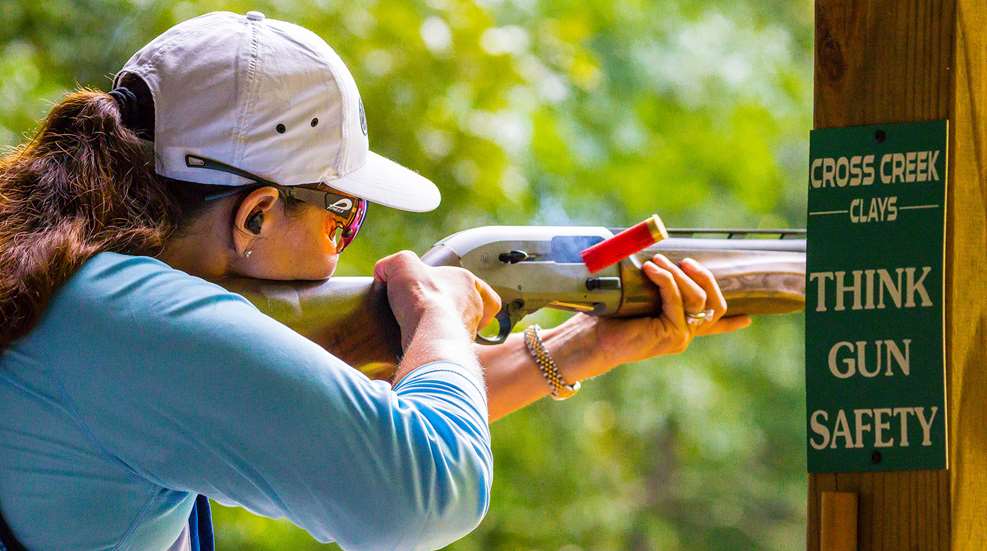
For most of the 20th century, skeet and trap were the big clay target games played in the U.S. Both are played on a field with a fixed size that doesn’t take up a ton of real estate, so gun clubs could have multiple fields on their property, each accommodating a handful of shooters at a time.
But in the late 1980s, the game we now call sporting clays made its way to the U.S. from England. It gained popularity quickly and is now, by most estimates, the most popular clay target game in America. It’s got a dramatically different set of rules and a different structure than skeet and trap, and because it is shot at different spread-out stations and participants often use a golf cart or ATV to travel between stations, it has earned the nickname “golf with a shotgun.” But while it’s easy to see where the comparison comes from, there are a number of reasons why sporting clays is more than that.
The Courses Are Always Changing
A typical sporting clays course will include between 10 and 18 stations that a group of shooters will navigate. Each station can be utilized by a different squad at the same time, so a course can accommodate a large number of people at once. Sounds like golf, right? The big difference is that although the stations don’t move, the targets thrown at any given station can be changed, and most clubs will re-set the course on a weekly or monthly basis. This means that the course you shot at the club two weeks ago might look the same, but the experience at each station can be radically different. The targets might come from a different direction and be presented at a different speed or angle, with different shooting windows and opportunities. The course looks the same, but it’s a whole next experience each time you shoot it. Golf can do this some an extent by moving the holes, but the course doesn’t change as drastically as a sporting clays course does.
Target setters can also recommend or dictate (in formal competition) that you shoot a given station as singles or pairs. “Report pairs” mean that you shoot the first target thrown, and the second target of the pair is released when you fire the gun. “True pairs” are when both targets are thrown simultaneously and you must choose the order in which to shoot them. Changing a station from report pairs to true pairs can be a radical shift by itself without even moving the trap machines.
In addition, the weather conditions can change how a course shoots. The same targets thrown against a clear blue sky, a gray stormy sky or a bunch of fluffy white clouds will all be approached a little bit differently. Good target setters take full advantage of terrain. Sporting clays courses can be set in wide open fields, in the middle of the woods, or anything in between. Just moving the angle of the station or the origin of the targets can bring trees and brush into play that weren’t a factor on the same station the last time you shot it.

Targets and Presentations are Changing
I’m no golf expert, but as far as I know, there haven’t been a ton of changes to green grass and golf balls in the past few decades. In contrast, in the past 30 years, clay targets have evolved, and we now have targets of different sizes and colors. The size in particular can change the way you approach your shot on a sporting clays course, as a smaller clay target (they come in mini and midi sizes and more) will look farther away than it actually is. The color of the target—orange-and-black, all-orange, all-black, pink, green, yellow, blue—changes the experience, and the color of the background plays a role as well.
The trap machines that throw the targets have evolved, too, and today’s machines can throw targets much faster and farther than just 10 years ago. They also have the ability to throw clays so that only a specific part of the target is visible as it flies through the air: just the edge as it flies sideways, the full top or “dome,” the full “belly,” or some combination. We can throw “rabbit” targets that hop along the ground. We can skip targets over the surface of a lake and bounce them off trampolines. We can utilize towers and scissor lifts to throw targets from way over your head or under your feet. The possibilities continue to expand.
There’s No Par—Sporting Clays Is for Everyone
One of the coolest things about sporting clays is how accessible it is to people of all skill levels. Whoever is setting the targets on the course can set them anywhere from super-easy to crazy-hard, depending on their goals. I’ve shot at 78 on my local course one week and a 43 the next because the first event was an easy charity shoot and the second was a are-you-ready-for-dove-season challenge. Same course, different target presentations.
There’s no par on the sporting clays course, no expectations that you’re “supposed to” break X number of targets. You can compete against other shooters or simply against yourself. A perfect score in a round of sporting clays is a 100, and on an average course, almost no one breaks that many. Even at the most difficult registered sporting clays competitions among the best shooters in the world, the highest score is usually somewhere in the mid-90s. The pressure to be perfect is just not a factor, unlike in skeet or trap, and the pressure to shoot “par” doesn’t exist.
With the right gun-and-ammo combo, nearly anyone can participate in sporting clays. I’ve seen shooters in power wheelchairs on the course. I’ve met a talented shooter who had only one arm. I’ve seen children as young as 5 (very carefully supervised and with proper equipment) and men well into their 90s shoot targets on a sporting clays course. They might not have broken as many targets as they once did or as they will someday, but they all had fun, which is really the object of the game that’s much more than “golf with a shotgun.”















































